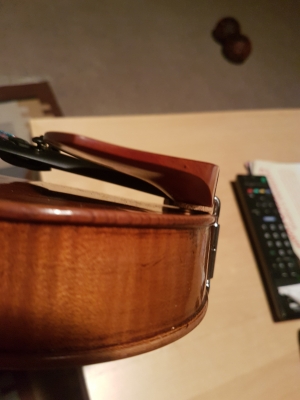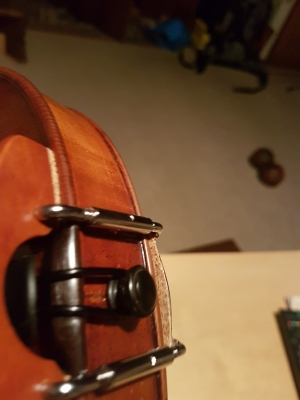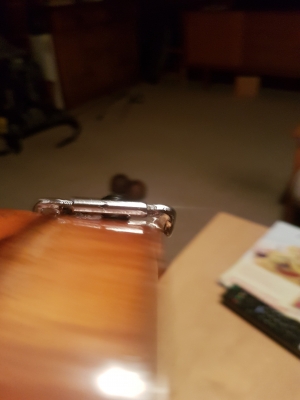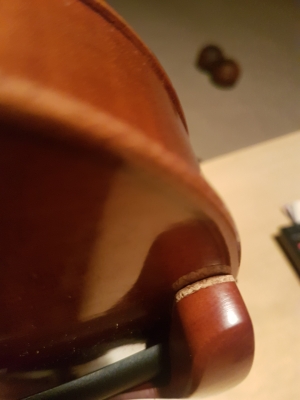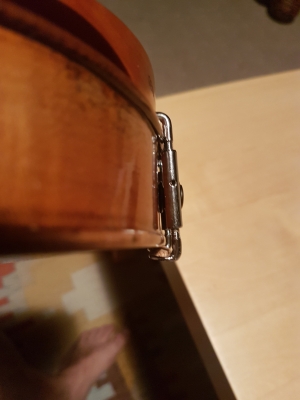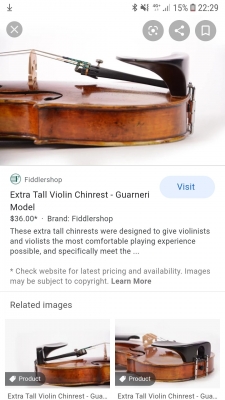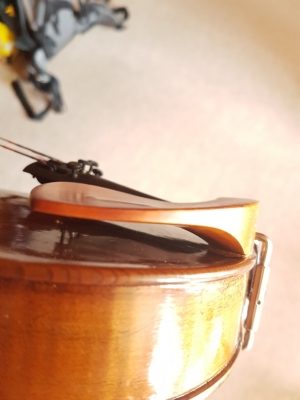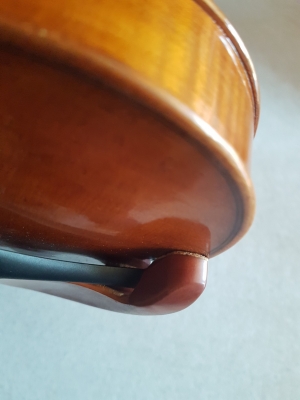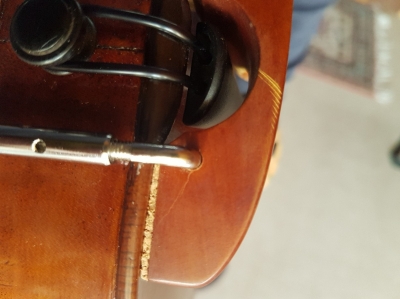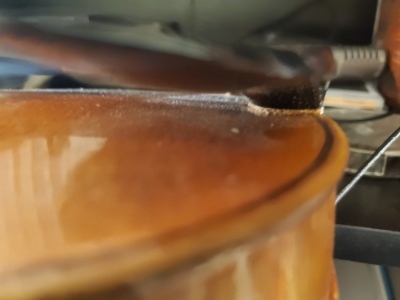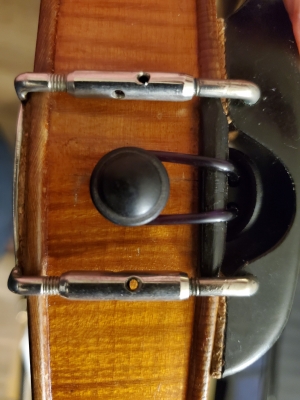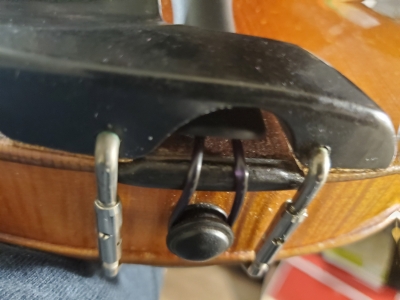Welcome to our forum. A Message To Our New and Prospective Members . Check out our Forum Rules. Lets keep this forum an enjoyable place to visit.
Currently working on errors from the latest (SimplePress) forum update. Many issues have been resoled and others are being worked on. Thank you for your patience.
 Topic RSS
Topic RSS



 (0 votes)
(0 votes)  Offline
Offline
Hi all,
just got myself a new chin rest as I wanted to try out something with a smaller hook for the jaw. However, when I tried to mount I could not find the optimal position - chin rest wise. It's a little hard to see on the pictures, but I will try my best to describe it.
When I put the bottom clamp flush with the bottom edge of the violin, the chin rest is not completely laying on the violin. If I want the chin rest to properly fit, I need the bottom clamp to move away from the edge. What should I do? Bend the screws? Obviously not where the thread is, but in the corners.. But I am not sure if I can achieve a proper fit just by bending or if the holes of the chinrest would need to be at a different angle at all.
I guess, the chin rest really needs to fit properly otherwise the while load is on the edge..
Any advice is highly welcome.
Regards
Good bottom clamp fit, bad chin rest fit (space of the feet)
If I want a good fit of the chin rest feet, the bottom clamp looks like this.
Regulars







Regulars
 Offline
Offline





Regulars
 Offline
Offline





Regulars







Oh, yes, that's the other thing. Please don't over-tighten. The chinrest should be clamped just enough to prevent it from moving as you play.
Regarding the picture, I would guess that taller chinrests might need to be clamped farther into the plate just to keep them in place. The chinrest should still be as close to the edge as possible without losing stability.
 Offline
Offline
I bent the screws a little and grinded the cork. Now it fits quite nicely. What do you think? The screws are not touching the violin at all and there is enough space between the tailpiece and the chin rest. My only concern is the little crack beside the right screw (you can see it on the picture). It's not broken and it didn't come loose at all. Should I try to put some glue on to fix the crack or replace the chinrest?
Regulars
 Offline
Offline





The crack may have been caused if there was a small object trapped between the end of the rest and the violin, in which case I hope it didn't damage the violin. I wouldn't worry about the crack, but if you have some liquid glue that could be soaked into it by capillary action, that might be a good thing to do, perhaps with the rest away from the violin. If you take it apart yet again, examine everything carefully just to make sure nothing else has come to any harm.
Andrew
Verified human - the ignominy!
Regulars
 Offline
Offline

@rokit . I think you are being guided by a faulty marketing photo. The end of the chin rest should be flush with the edge of the top plate, exposing the least amount of top leg of the metal “L” chin rest mounting bracket. Again, I agree with AndrewH on this point. The included angle of the bracket should be 90 degrees.
The wood in the area of the crack is not receiving any compression loading and should not give you any trouble. Repair with a light viscosity ca glue would be appropriate.
In a contemporary post with video, you complained that short arms prevented adequate extension for full length bowing. In large part, I think you will easily accommodate full extension by gaining wrist flexibility. Having your chin centered over the violin corpus (which appears to be the reason for your new chin rest) will also maximize available arm extension. I have no issue with bowing arm length, but gravitate toward the Flesch style of chin rest (which puts the chin directly over the tail piece). If your neck is long enough to handle it, such a chin rest may afford an advantage over your current experiment. Fortunately, the chin rest is an affordable accessory.
Success is the progressive realisation of a worthy ideal. —Earl Nightingale.
 Offline
Offline
@Irv
Thanks for your answer. Yeah, you're right. I wanted to find a more comfortable way of playing. Maybe I have to try a Flesch chin rest as well.
I am a little concerned about a Flesch like chin rest as I think ( and only think, because I really don't know) I will hold the violin more in front of me. And by front I mean a greater angle than 45°.
I even don't know if this is good or bad, but I thought the way I have it now is quite ok.
This is a video with the new chin rest.. but still with a stiff wrist.
Regulars
 Offline
Offline

@rokit . If you notice your chin location in the video, you are already centered on the midline of the corpus. The Flesch will just allow you that position with more comfort.
By the way, I already see improvement on all aspects of your bowing.
Success is the progressive realisation of a worthy ideal. —Earl Nightingale.
Regulars







rokit said
@IrvThanks for your answer. Yeah, you're right. I wanted to find a more comfortable way of playing. Maybe I have to try a Flesch chin rest as well.
I am a little concerned about a Flesch like chin rest as I think ( and only think, because I really don't know) I will hold the violin more in front of me. And by front I mean a greater angle than 45°.
I even don't know if this is good or bad, but I thought the way I have it now is quite ok.
If you have short arms, you SHOULD hold the violin more in front of you. There is no one-size-fits-all posture.
I'd estimate that I hold my viola about 55° out to the front.
Regulars
 Offline
Offline

@rokit and @AndrewH . Once again I am in complete agreement with AndrewH (who I am sure can play complete circles around me). I am just relying upon ergonomics. We are likely in the minority to what is traditionally being taught, and I could care less.
Success is the progressive realisation of a worthy ideal. —Earl Nightingale.
 Offline
Offline
@Fiddlerman I don't think it is only this chinrest in particular with such "bold" feet. As far as I can see, all center mounted chinrests have this kind of feet: Guarneri, Flesch, etc..
All side mounted chinrests have a the narrow ridge.
So maybe I should ask, how to should the chinrests with bold feet be mounted at all? Maybe someone could post a picture of his setup with a center mount (picture from the side), that we can see where the feet should be placed. I haven't found anywhere a guide or even a picture of how and especially where the bold feet should be placed. Because I think most of the time you need to grind some cork away.
Anyway, I would highly appreciate if somebody could post a picture of such a chinrest (maybe mounted by a luthier).
Regulars







The cork should almost never need to be cut. I have never had to remove any cork with any of the chinrests I have used. As long as the chinrest isn't tilted upward, the cork doesn't need to be flush against the top of the violin, and it is highly compressible so there will be more contact if you tighten the clamp just a little bit more while keeping the clamp level. There only needs to be enough contact to ensure that the chinrest does not move while you are playing. Also, ideally neither the top nor the bottom clamp should touch the edge of the violin, although sometimes it may be necessary for stability.
Regulars







These images are of the mounting for the Guarneri chinrest on my violin. I mainly play the viola, so the chinrest has not been changed since I acquired it in 1996 and started playing it in 1999. It most likely has not been changed since my great-uncle purchased the violin brand-new in 1954, as violin accessories would have been hard to come by in Taiwan in the 1950s through 1970s and the violin was in the hands of a non-playing family member between 1977 and 1996.
Note that the cork pad is almost exactly at the edge of the instrument, and even protrudes slightly from the edge at the right side. The clamps do not touch the edge of the violin at top or bottom. Although the cork thickness is not uniform, this is because of compression rather than removal.
If you want, I can also provide images of my viola chinrest, but my viola has a side-mounted chinrest. With my viola chinrest, installed in 2018, a little over half of the cork is in contact with the top plate.


 Log In
Log In Register
Register





